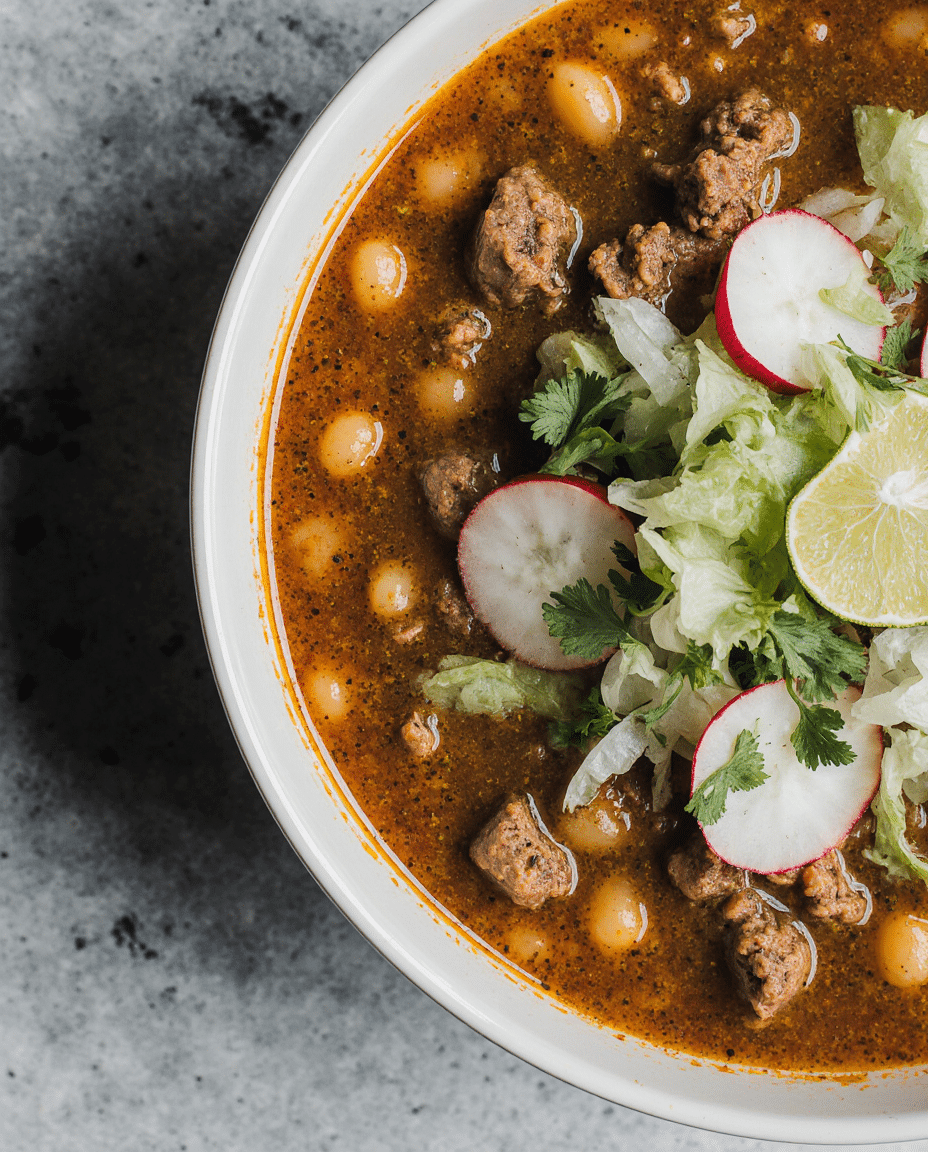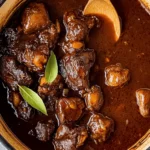Pozole is a beloved traditional Mexican soup that comes in different regional variations, the most popular being Pozole Rojo (red) and Pozole Verde (green). This hearty and celebratory dish is made with large white hominy kernels and typically features pork or chicken in a richly flavored broth. Rojo is made with dried red chilies for a smoky, earthy heat, while Verde uses tomatillos, green chilies, and herbs for a vibrant, tangy flavor.
FULL RECIPE
Ingredients
1.For the Base Pozole (both versions):
- 2 pounds pork shoulder or chicken (bone-in preferred)
- 12 cups water
- 1 tablespoon salt
- 2 bay leaves
- 1 medium onion, halved
- 5 garlic cloves, peeled
- 2 (25 oz) cans white hominy, drained and rinsed
2.Pozole Rojo Sauce:
- 4 dried guajillo chilies, stemmed and seeded
- 2 dried ancho chilies, stemmed and seeded
- 2 cloves garlic
- 1/2 teaspoon cumin
- 1/2 teaspoon oregano
- 1 cup broth (from boiled meat)
3.Pozole Verde Sauce:
- 8 tomatillos, husked and rinsed
- 2 poblano peppers, seeded
- 1 jalapeño (optional for spice)
- 1/2 cup fresh cilantro
- 1/2 cup fresh parsley
- 1/2 white onion, chopped
- 2 cloves garlic
- 1/2 teaspoon cumin
- 1/2 teaspoon oregano
4.Toppings (for either version):
- Shredded cabbage or lettuce
- Thinly sliced radishes
- Diced white onion
- Chopped cilantro
- Lime wedges
- Dried oregano
- Crushed red pepper
- Tostadas or tortilla chips
Directions
- In a large stockpot, combine the pork or chicken, water, salt, bay leaves, onion, and garlic. Bring to a boil, then reduce heat and simmer for about 1.5 hours, skimming foam as needed.
- Once meat is tender, remove it from the pot. Shred and set aside. Discard bay leaves, onion, and garlic. Reserve the broth.
- Add the hominy to the reserved broth and simmer uncovered over low heat.
- For Rojo: Soak dried chilies in hot water for 20 minutes until soft. Blend with garlic, cumin, oregano, and 1 cup broth until smooth. Strain if desired.
- For Verde: Boil tomatillos and green peppers until soft. Blend with jalapeño, onion, garlic, cilantro, parsley, cumin, and oregano until smooth. Strain if desired.
- Stir your chosen sauce (Rojo or Verde) into the pot with hominy. Simmer for 20–30 minutes, allowing the flavors to meld.
- Return the shredded meat to the pot and simmer another 10 minutes.
- Taste and adjust salt as needed.
- Serve hot with your favorite toppings on the side for a customizable experience.
Nutrition Facts
- Calories: 390
- Total Fat: 17g
- Saturated Fat: 6g
- Cholesterol: 70mg
- Sodium: 680mg
- Total Carbohydrates: 32g
- Dietary Fiber: 6g
- Sugars: 3g
- Protein: 28g
- Vitamin C: 20% DV
- Iron: 15% DV
- Calcium: 8% DV
Cultural Roots and Festive Symbolism
Pozole has deep cultural significance in Mexico, especially during major celebrations like Mexican Independence Day, Christmas, and New Year’s. Historically, it dates back to pre-Columbian times and was considered a sacred dish among the Aztecs, made with ceremonial intent. Today, it’s a festive centerpiece that brings people together to celebrate heritage and community. The colorful toppings and the choice between red (rojo) and green (verde) sauces even echo the Mexican flag, making this dish symbolically perfect for national pride celebrations.
Pozole Rojo vs. Pozole Verde: Flavor Differences
Pozole Rojo and Pozole Verde differ dramatically in taste and appearance, though they share the same comforting foundation. Rojo, made with dried red chilies like guajillo and ancho, has a smoky, earthy, and mildly spicy flavor that delivers warmth and depth. Verde, on the other hand, is vibrant and tangy, often made with tomatillos, poblano peppers, and fresh herbs, resulting in a more refreshing and herbaceous profile. Your choice between the two comes down to personal preference and desired spice level, but both versions remain rooted in tradition.
Health Benefits of Pozole Ingredients
Pozole is not only delicious but can also be nourishing, especially when prepared with wholesome ingredients. Hominy, the main ingredient, is a good source of dietary fiber and B vitamins. When made with lean pork or skinless chicken, the soup becomes a protein-rich, low-fat option. The addition of herbs and chilies brings antioxidants, while fresh toppings like cabbage and radishes contribute essential vitamins. Pozole Verde, in particular, offers a lighter, vitamin C-rich broth thanks to tomatillos and green peppers, making it a satisfying yet health-conscious choice.
Serving and Topping Traditions
One of the most enjoyable aspects of pozole is how it’s served—with a wide array of toppings laid out buffet-style so guests can customize their bowls. Traditional garnishes include shredded lettuce or cabbage, sliced radishes, chopped onion, dried oregano, and lime wedges. Crushed red pepper and tostadas or tortilla chips are also commonly offered for added crunch and heat. This interactive presentation adds fun and festivity to the meal, turning it into a communal experience where everyone builds their perfect bowl.
Ideal Pairings for a Full Meal
Pozole is quite hearty on its own, but pairing it with other traditional Mexican dishes or drinks enhances the culinary experience. Fresh corn tortillas, quesadillas, or tamales make excellent accompaniments. For drinks, consider aguas frescas like hibiscus (jamaica) or horchata to balance the spiciness. Adults might enjoy pozole with Mexican beer or a light tequila-based cocktail. Pozole Verde pairs particularly well with citrus-forward beverages, while Rojo benefits from smoky or roasted drink flavors.
Regional Variations Across Mexico
While Rojo and Verde are the most widely known, there’s also Pozole Blanco—a simpler, uncolored version made without added sauces. Each region of Mexico has its twist: Guerrero favors Verde with lots of herbs and pumpkin seeds; Jalisco and Michoacán lean into Rojo with bold spice; and Mexico City offers Blanco with minimalist seasoning, letting the hominy and meat shine. These regional touches showcase the diversity and adaptability of pozole in Mexican cuisine.
Tips for Making Pozole in Advance
Pozole is a fantastic make-ahead dish because it tastes even better the next day after the flavors have had time to develop. When preparing ahead, store the soup base separately from the toppings to maintain texture and freshness. Once cooled, refrigerate the pozole in airtight containers for up to 4 days. For longer storage, it freezes beautifully—just leave a bit of headspace in your containers for expansion. Reheat gently on the stove and add fresh lime and garnishes just before serving.
Customization for Dietary Preferences
Pozole can be easily tailored to suit a variety of dietary needs. For a vegetarian version, replace the meat with mushrooms or jackfruit and use vegetable broth. Vegan pozole is just as rich when flavored with the same chili or tomatillo bases. Gluten-free eaters will be happy to know that traditional pozole is naturally gluten-free, especially when made with care to avoid cross-contamination. For those watching their sodium or fat intake, opt for low-sodium broth and lean proteins like chicken breast.
How to Choose the Best Hominy
Hominy is a key ingredient in pozole, so choosing a high-quality variety makes a big difference. Canned hominy is convenient and widely available, but for the best texture and flavor, rinse it thoroughly before use to remove excess sodium and brine. If you have time, dried hominy offers superior chewiness and absorbs the broth’s flavor beautifully—just be sure to soak and simmer it properly before adding to the soup. White hominy is traditional, but yellow hominy works in a pinch and adds a touch of sweetness.
Advertisement
Cooking Techniques for Best Flavor
The secret to a rich, flavorful pozole lies in slow simmering. Allowing the meat to cook gently over time not only tenderizes it but also infuses the broth with deep, savory notes. Roasting or toasting chilies and tomatillos before blending brings out their natural sweetness and smoky qualities, intensifying the final broth. When blending sauces, strain them for a smooth, velvety texture that’s easy to mix into the soup base. Layer your seasoning gradually—taste often and adjust salt, spice, or acidity as needed.
Conclusion
Pozole Rojo or Verde is more than just a soup—it’s a centerpiece of tradition, celebration, and comfort. Its rich cultural roots, complex flavors, and adaptable ingredients make it a favorite not only during Mexican Independence Day but also for everyday enjoyment and family gatherings. With endless customization options and a built-in interactive presentation through toppings, pozole brings warmth, flavor, and festivity to any table.






